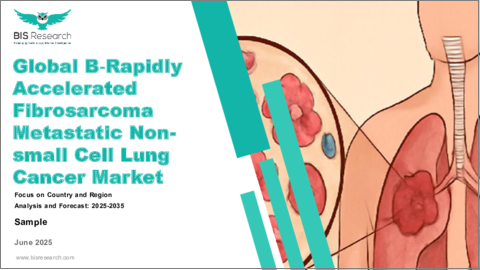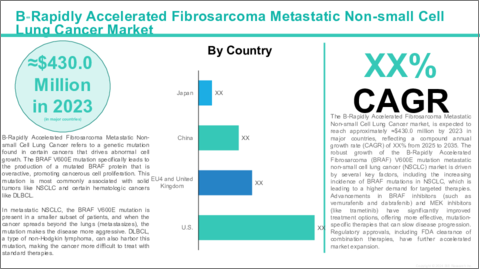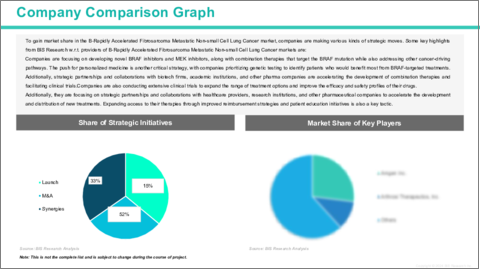|
|
市場調査レポート
商品コード
1757397
B型急速進行性線維肉腫転移性非小細胞肺がんの世界市場:国別、地域別 - 分析と予測(2025年~2035年)Global B-Rapidly Accelerated Fibrosarcoma Metastatic Non-small Cell Lung Cancer Market: Focus on Country, and Region - Analysis and Forecast, 2025-2035 |
||||||
カスタマイズ可能
|
|||||||
| B型急速進行性線維肉腫転移性非小細胞肺がんの世界市場:国別、地域別 - 分析と予測(2025年~2035年) |
|
出版日: 2025年06月27日
発行: BIS Research
ページ情報: 英文 100 Pages
納期: 1~5営業日
|
全表示
- 概要
- 図表
- 目次
B型急速進行性線維肉腫転移性非小細胞肺がんとびまん性大細胞型B細胞リンパ腫(DLBCL)は、B型急速進行性線維肉腫タンパク質の異常な活性化を引き起こし、制御不能な細胞増殖を促進するB型急速進行性線維肉腫 V600E変異によって駆動される2つの侵攻性がんです。
転移性非小細胞肺がんでは、B型急速進行性線維肉腫 V600E変異は患者のごく一部、特に非喫煙者や若年者に発生し、この疾患をより治療困難なものにしています。がんが進行して転移を起こすと、他の臓器に転移し、予後を複雑にします。同様にDLBCLでは、B型急速進行性線維肉腫 V600E変異がリンパ腫細胞の急速な増殖に寄与していますが、このタイプのがんでは非小細胞肺がんに比べてあまり見られません。B型急速進行性線維肉腫阻害剤(ダブラフェニブやベムラフェニブなど)やMEK阻害剤(トラメチニブなど)などの標的療法は、変異を特異的に標的とし、がんの進行を促す異常なシグナル伝達経路を遮断することにより、B型急速進行性線維肉腫転移性非小細胞肺がんの両方の治療に有望であることを示しています。
これらの治療法は、従来の化学療法と比較して患者の転帰に大きな改善をもたらし、これらの侵攻性のがんを管理するためのより個別化された効果的なアプローチを提供します。
B型急速進行性線維肉腫転移性非小細胞肺がん市場の主要促進要因の一つは、標的療法の採用が拡大していることです。
B型急速進行性線維肉腫V600E変異が実用的な標的として認識されたことにより、B型急速進行性線維肉腫阻害剤(ダブラフェニブ、ベムラフェニブなど)およびMEK阻害剤(トラメチニブなど)の需要が急増しました。このような精密腫瘍学へのシフトは、従来の化学療法に比べて治療効果を向上させ、副作用を軽減しています。
遺伝子検査によってB型急速進行性線維肉腫 V600E変異と診断される患者が増えるにつれて、これらの標的治療薬の市場は拡大し続けています。さらに、B型急速進行性線維肉腫阻害剤と免疫チェックポイント阻害剤などの他の治療との併用が有望な結果を示しており、市場拡大をさらに後押ししています。個々の遺伝子プロファイルに合わせた治療を行う個別化医療への注目が高まっていることも、B型急速進行性線維肉腫-mutant cancer treatment市場の成長に大きく寄与しています。
B型急速進行性線維肉腫転移性非小細胞肺がんおよびびまん性大細胞型B細胞リンパ腫(DLBCL)市場の成長にもかかわらず、いくつかの課題が引き続きその可能性を完全に阻害しています。B型進行性線維肉腫転移性非小細胞肺がん市場における主な課題の1つは、標的治療薬に対する耐性開発です。B型急速進行性線維肉腫阻害剤とMEK阻害剤はB型急速進行性線維肉腫V600E変異がんの治療に大きな有効性を示しているが、多くの患者は耐性機序の出現により最終的に腫瘍の進行を経験します。
B型急速進行性線維肉腫遺伝子の二次変異や代替シグナル伝達経路の活性化など、これらの耐性機序は治療効果を低下させるため、次世代療法や併用療法の開発が必要となります。さらに、B型急速進行性線維肉腫転移性非小細胞肺がんの有病率が比較的低いため、市場規模が限定され、EGFRやALKのような一般的な変異と比較してニッチなセグメントとなっています。もう一つの課題は、標的治療薬のコストが高いことで、特に中低所得国では患者アクセスが制限される可能性があります。これらの課題に対処するためには、併用療法や次世代薬剤の継続的な調査と技術革新、そして治療へのアクセシビリティの向上が必要です。
世界のB型急速進行性線維肉腫転移性非小細胞肺がん市場は競争が激しく、複数の主要企業が技術革新と市場成長を牽引しています。Novartis AGやPfizer Inc.などの主要企業が最前線に立ち、腫瘍学と精密医療における専門知識を活用して、B型急速進行性線維肉腫-変異型がんに対する画期的な治療法を開発しています。TAFINLAR(ダブラフェニブ)とMEKINIST(トラメチニブ)の併用療法を有するNovartisは、B型急速進行性線維肉腫転移性非小細胞肺がん市場における主要参入企業であり、患者の転帰を著しく改善する効果的な標的治療を提供しています。同様に、Pfizerは、B型急速進行性線維肉腫 TOVI(エンコラフェニブ)とMEKTOVI(ビニメチニブ)の併用療法で市場を前進させ、B型急速進行性線維肉腫 V600E変異転移性非小細胞肺がんとメラノーマの治療選択肢を強化しています。これらの企業は、治療ポートフォリオの開発・拡大に注力しているだけでなく、薬剤耐性などの課題を克服するために、新たな併用療法やセカンドライン治療を模索する臨床研究や臨床試験にも投資しています。標的治療、遺伝子検査、個別化医療の進展に向けた継続的な取り組みにより、これらの企業は急速に発展するB型急速進行性線維肉腫転移性がん治療市場のリーダーとしての地位を確立しています。
B型急速進行性線維肉腫転移性非小細胞肺がん市場のセグメンテーション:
セグメンテーション1:地域別
- 北米
- 欧州
- アジア太平洋
- その他の地域
世界のB型急速進行性線維肉腫転移性非小細胞肺がんおよびびまん性大細胞型B細胞リンパ腫(DLBCL)市場は、いくつかの新たな動向に牽引され、大きな成長を遂げています。主要な動向は、標的治療への注目の高まりであり、ダブラフェニブやベムラフェニブのようなB型急速進行性線維肉腫阻害剤とトラメチニブのようなMEK阻害剤との併用療法が、B型急速進行性線維肉腫変異型がんの治療の中心となっています。さらに、B型急速進行性線維肉腫阻害剤と免疫チェックポイント阻害剤を組み合わせた併用療法が人気を集めており、耐性を克服して有効性を高め、患者の転帰を改善しています。個別化医療と精密腫瘍学へのシフトも重要な動向であり、B型急速進行性線維肉腫変異の遺伝子検査により、よりテーラーメイドの治療が可能となり、より高い有効性と最小限の副作用が保証されます。さらに、DLBCLに対するB型急速進行性線維肉腫標的治療法の調査が拡大しており、この侵攻性リンパ腫に新たな治療選択肢を提供しています。臨床試験への投資の増加や規制当局の承認拡大も市場成長に寄与しており、革新的治療への幅広いアクセスが確保されています。これらの動向は、B型急速進行性線維肉腫転移性がん治療の展望を再構築し、継続的な市場拡大を促進し、世界中の患者に新たな希望をもたらしています。
当レポートでは、世界のB型急速進行性線維肉腫転移性非小細胞肺がん市場について調査し、市場の概要とともに、国別、地域別 の動向、および市場に参入する企業のプロファイルなどを提供しています。
目次
エグゼクティブサマリー
第1章 世界のB型急速進行性線維肉腫転移性非小細胞肺がん市場:業界見通し
- イントロダクション
- 市場動向
- 規制の枠組み
- 疫学分析
- 臨床試験分析
- 市場力学
- 影響分析
- 市場の促進要因
- 市場の課題
- 市場の機会
第2章 世界のB型急速進行性線維肉腫転移性非小細胞肺がん市場(地域別)、2023年~2035年
- 北米
- 欧州
- アジア太平洋
第3章 世界のB型急速進行性線維肉腫転移性非小細胞肺がん市場:競合情勢と企業プロファイル
- 主要戦略と開発
- 合併と買収
- 相乗効果のある活動
- 事業拡大と資金調達
- 製品の発売と承認
- その他の活動
- 企業プロファイル
- Novartis AG
- Pfizer Inc.
第4章 調査手法
List of Figures
- Figure: Global B-Rapidly Accelerated Fibrosarcoma Metastatic Non-small Cell Lung Cancer Market (by Region), $Billion, 2024 and 2035
- Figure: Global B-Rapidly Accelerated Fibrosarcoma Metastatic Non-small Cell Lung Cancer Market Key Trends, Analysis
List of Tables
- Table: Global B-Rapidly Accelerated Fibrosarcoma Metastatic Non-small Cell Lung Cancer Market Dynamics, Impact Analysis
- Table: Global B-Rapidly Accelerated Fibrosarcoma Metastatic Non-small Cell Lung Cancer Market (by Region), $Billion, 2024-2035
B-rapidly accelerated fibrosarcoma metastatic non-small cell lung cancer (Non-small Cell Lung Cancer) and diffuse large B-cell lymphoma (DLBCL) are two aggressive cancers driven by the B-rapidly accelerated fibrosarcoma V600E mutation, which leads to abnormal activation of the B-rapidly accelerated fibrosarcoma protein, promoting uncontrolled cell growth.
In metastatic Non-small Cell Lung Cancer, the B-rapidly accelerated fibrosarcoma V600E mutation occurs in a small subset of patients, particularly non-smokers or younger individuals, making the disease more challenging to treat. As the cancer progresses to metastatic stages, it spreads to other organs, complicating the prognosis. Similarly, in DLBCL, the B-rapidly accelerated fibrosarcoma V600E mutation contributes to the rapid growth of lymphoma cells, although it is less commonly seen in this type of cancer compared to Non-small Cell Lung Cancer. Targeted therapies, such as B-rapidly accelerated fibrosarcoma inhibitors (e.g., dabrafenib and vemurafenib) and MEK inhibitors (e.g., trametinib), have shown promise in treating both B-rapidly accelerated fibrosarcoma metastatic non-small cell lung cancer by specifically targeting the mutation and blocking the aberrant signalling pathways driving cancer progression.
These therapies offer significant improvements in patient outcomes compared to traditional chemotherapy, providing a more personalized and effective approach to managing these aggressive cancers.
One of the key drivers of the B-rapidly accelerated fibrosarcoma metastatic non-small cell lung cancer market is the growing adoption of targeted therapies.
The recognition of the B-rapidly accelerated fibrosarcoma V600E mutation as an actionable target has led to a surge in demand for B-rapidly accelerated fibrosarcoma inhibitors (e.g., dabrafenib and vemurafenib) and MEK inhibitors (e.g., trametinib), which are specifically designed to block the mutated B-rapidly accelerated fibrosarcoma protein and its downstream signalling pathways. This shift towards precision oncology is improving the effectiveness of treatment and reducing side effects compared to traditional chemotherapy.
As more patients are diagnosed with B-rapidly accelerated fibrosarcoma V600E mutations through genetic testing, the market for these targeted therapies continues to grow. Additionally, the combination of B-rapidly accelerated fibrosarcoma inhibitors with other treatments, such as immune checkpoint inhibitors, is showing promising results, further driving market expansion. The increasing focus on personalized medicine, where treatments are tailored to individual genetic profiles, is another significant factor contributing to the growth of the B-rapidly accelerated fibrosarcoma -mutant cancer treatment market.
Despite the growth of the B-rapidly accelerated fibrosarcoma metastatic non-small cell lung cancer (Non-small Cell Lung Cancer) and diffuse large B-cell lymphoma (DLBCL) market, several challenges continue to impede its full potential. One of the primary challenges in the B-rapidly accelerated fibrosarcoma metastatic non-small cell lung cancer market is the development of resistance to targeted therapies. While B-rapidly accelerated fibrosarcoma inhibitors and MEK inhibitors have shown significant efficacy in treating B-rapidly accelerated fibrosarcoma V600E-mutant cancers, many patients eventually experience tumour progression due to the emergence of resistance mechanisms.
These resistance mechanisms, such as secondary mutations in the B-rapidly accelerated fibrosarcoma gene or activation of alternative signalling pathways, reduce the effectiveness of treatment, requiring the development of next-generation therapies or combination treatments. Additionally, the relatively low prevalence of the B-rapidly accelerated fibrosarcoma metastatic non-small cell lung cancer limits the market size, making it a niche segment compared to more common mutations like EGFR and ALK. Another challenge is the high cost of targeted therapies, which can restrict patient access, especially in low- and middle-income countries. Addressing these challenges requires continued research and innovation in combination therapies, next-generation drugs, and improving accessibility to treatment.
The global B-rapidly accelerated fibrosarcoma metastatic non-small cell lung cancer market is highly competitive, with several key players driving innovation and market growth. Leading companies such as Novartis AG and Pfizer Inc. are at the forefront, leveraging their expertise in oncology and precision medicine to develop groundbreaking therapies for B-rapidly accelerated fibrosarcoma -mutant cancers. Novartis, with its combination of TAFINLAR (dabrafenib) and MEKINIST (trametinib), is a key player in the B-rapidly accelerated fibrosarcoma metastatic non-small cell lung cancer market, offering effective targeted treatments that have significantly improved patient outcomes. Similarly, Pfizer is advancing the market with its B-rapidly accelerated fibrosarcoma TOVI (encorafenib) and MEKTOVI (binimetinib) combination therapy, providing enhanced treatment options for B-rapidly accelerated fibrosarcoma V600E-mutant metastatic Non-small Cell Lung Cancer and melanoma. These companies are not only focused on developing and expanding their treatment portfolios but are also investing in clinical research and clinical trials to explore new combination therapies and second-line treatments to overcome challenges like drug resistance. Their continued efforts in advancing targeted therapies, genetic testing, and personalized medicine are positioning them as leaders in the rapidly evolving B-rapidly accelerated fibrosarcoma -mutant cancer treatment market.
B-Rapidly Accelerated Fibrosarcoma Metastatic Non-small Cell Lung Cancer Market Segmentation:
Segmentation 1: by Region
- North America
- Europe
- Asia-Pacific
- Rest of the World
The global B-rapidly accelerated fibrosarcoma metastatic non-small cell lung cancer (Non-small Cell Lung Cancer) and diffuse large B-cell lymphoma (DLBCL) market is experiencing significant growth, driven by several emerging trends. A key trend is the increasing focus on targeted therapies, with B-rapidly accelerated fibrosarcoma inhibitors like dabrafenib and vemurafenib, in combination with MEK inhibitors such as trametinib, becoming central to the treatment of B-rapidly accelerated fibrosarcoma -mutant cancers. Additionally, combination therapies that pair B-rapidly accelerated fibrosarcoma inhibitors with immune checkpoint inhibitors are gaining traction, offering enhanced efficacy by overcoming resistance and improving patient outcomes. The shift towards personalized medicine and precision oncology is another important trend, as genetic testing for B-rapidly accelerated fibrosarcoma mutations allows for more tailored treatments, ensuring better efficacy and minimizing side effects. Furthermore, research into B-rapidly accelerated fibrosarcoma -targeted therapies for DLBCL is expanding, providing new treatment options for this aggressive lymphoma. Increased investment in clinical trials and the expansion of regulatory approvals is also contributing to market growth, ensuring broader access to innovative treatments. These trends are reshaping the landscape of B-rapidly accelerated fibrosarcoma -mutant cancer therapies, driving continued market expansion and offering new hope for patients worldwide.
Table of Contents
Executive Summary
Scope and Definition
Market/Product Definition
Inclusion and Exclusion
Key Questions Answered
Analysis and Forecast Note
1. Global B-Rapidly Accelerated Fibrosarcoma Metastatic Non-small Cell Lung Cancer Market: Industry Outlook
- 1.1 Introduction
- 1.2 Market Trends
- 1.3 Regulatory Framework
- 1.4 Epidemiology Analysis
- 1.5 Clinical Trial Analysis
- 1.6 Market Dynamics
- 1.6.1 Impact Analysis
- 1.6.2 Market Drivers
- 1.6.3 Market Challenges
- 1.6.4 Market Opportunities
2. Global B-Rapidly Accelerated Fibrosarcoma Metastatic Non-small Cell Lung Cancer Market (Region), ($Billion), 2023-2035
- 2.1 North America
- 2.1.1 Key Findings
- 2.1.2 Market Dynamics
- 2.1.3 Market Sizing and Forecast
- 2.1.3.1 North America B-Rapidly Accelerated Fibrosarcoma Metastatic Non-small Cell Lung Cancer Market, by Country
- 2.1.3.1.1 U.S.
- 2.1.3.1 North America B-Rapidly Accelerated Fibrosarcoma Metastatic Non-small Cell Lung Cancer Market, by Country
- 2.2 Europe
- 2.2.1 Key Findings
- 2.2.2 Market Dynamics
- 2.2.3 Market Sizing and Forecast
- 2.2.3.1 Europe B-Rapidly Accelerated Fibrosarcoma Metastatic Non-small Cell Lung Cancer Market, by Country
- 2.2.3.1.1 Germany
- 2.2.3.1.2 U.K.
- 2.2.3.1.3 France
- 2.2.3.1.4 Italy
- 2.2.3.1 Europe B-Rapidly Accelerated Fibrosarcoma Metastatic Non-small Cell Lung Cancer Market, by Country
- 2.3 Asia Pacific
- 2.3.1 Key Findings
- 2.3.2 Market Dynamics
- 2.3.3 Market Sizing and Forecast
- 2.3.3.1 Asia Pacific B-Rapidly Accelerated Fibrosarcoma Metastatic Non-small Cell Lung Cancer Market, by Country
- 2.3.3.1.1 China
- 2.3.3.1.2 Japan
- 2.3.3.1 Asia Pacific B-Rapidly Accelerated Fibrosarcoma Metastatic Non-small Cell Lung Cancer Market, by Country
3. Global B-Rapidly Accelerated Fibrosarcoma Metastatic Non-small Cell Lung Cancer Market: Competitive Landscape and Company Profiles
- 3.1 Key Strategies and Development
- 3.1.1 Mergers and Acquisitions
- 3.1.2 Synergistic Activities
- 3.1.3 Business Expansions and Funding
- 3.1.4 Product Launches and Approvals
- 3.1.5 Other Activities
- 3.2 Company Profiles
- 3.2.1 Novartis AG
- 3.2.1.1 Overview
- 3.2.1.2 Top Products / Product Portfolio
- 3.2.1.3 Top Competitors
- 3.2.1.4 Target Customers/End-Users
- 3.2.1.5 Key Personnel
- 3.2.1.6 Analyst View
- 3.2.2 Pfizer Inc.
- 3.2.2.1 Overview
- 3.2.2.2 Top Products / Product Portfolio
- 3.2.2.3 Top Competitors
- 3.2.2.4 Target Customers/End-Users
- 3.2.2.5 Key Personnel
- 3.2.2.6 Analyst View
- 3.2.1 Novartis AG






